| |
|
|
10.
| Connections |
| |

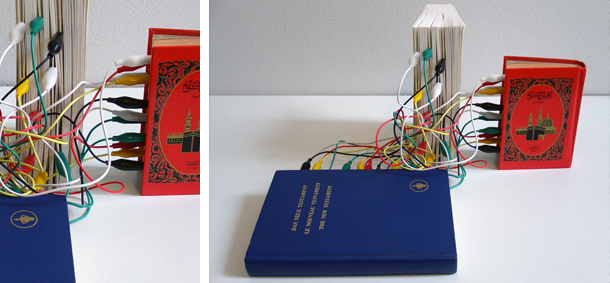
Serie started in 2006, inkjet prints, 75 x 100 and 120 x 160 cm.
Ed. of 5 + 2 A.P.
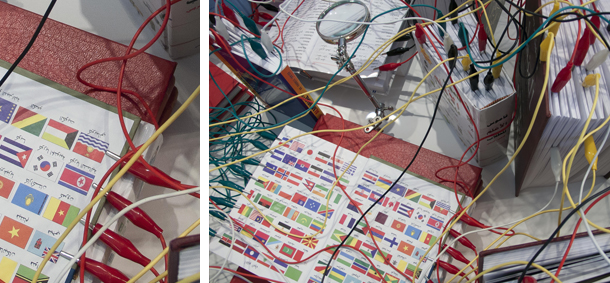
Serie started in 2006, inkjet prints, 105 x 160 cm.
Ed. of 5 + 2 A.P.
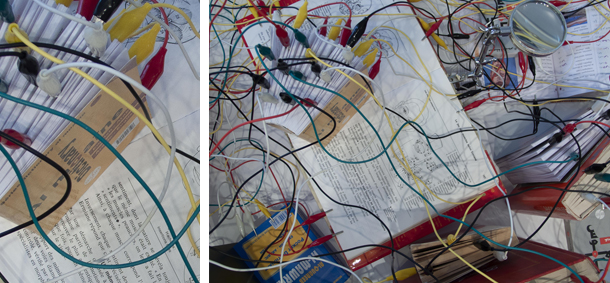
Serie started in 2006, inkjet prints, 105 x 160 cm.
Ed. of 5 + 2 A.P.
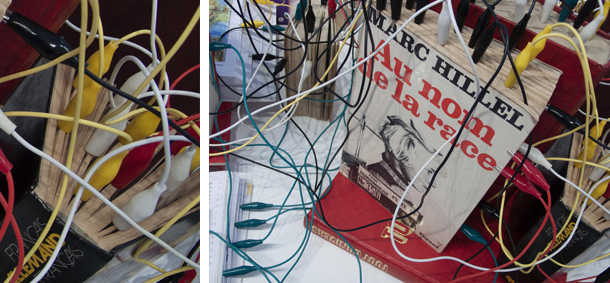
Serie started in 2006, inkjet prints, 105 x 160 cm.
Ed. of 5 + 2 A.P.
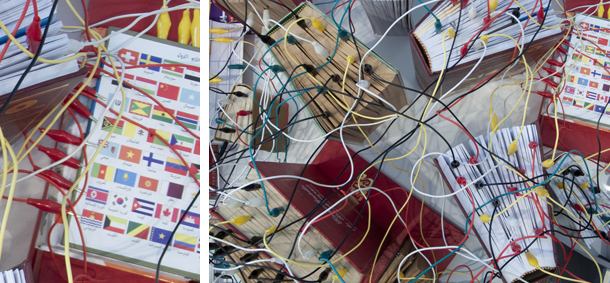
Serie started in 2006, inkjet prints, 105 x 160 cm.
Ed. of 5 + 2 A.P.

Serie started in 2006, inkjet prints, 105 x 160 cm.
Ed. of 5 + 2 A.P.
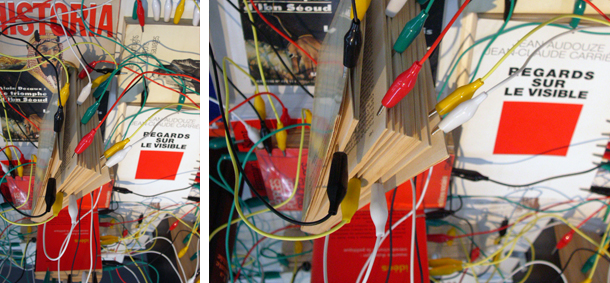
Serie started in 2006, inkjet prints, 160 x 105 cm.
Ed. of 5 + 2 A.P.
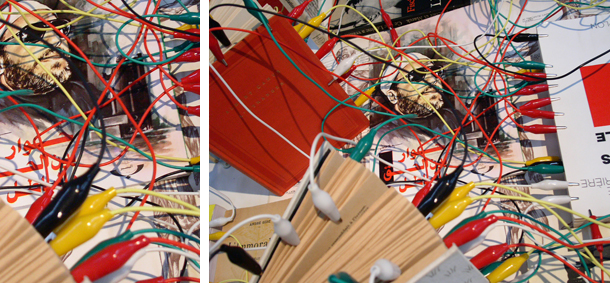
Serie started in 2006, inkjet prints, 105 x 160 cm.
Ed. of 5 + 2 A.P.
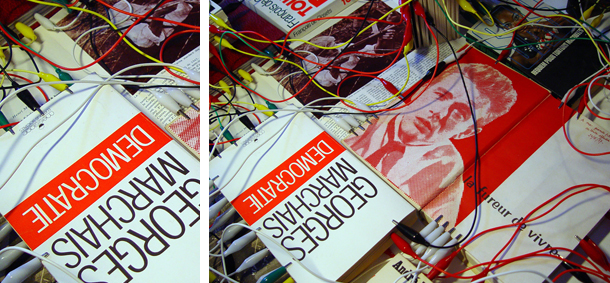
Serie started in 2006, inkjet prints, 105 x 160 cm.
Ed. of 5 + 2 A.P.

Serie started in 2006, inkjet prints, 105 x 160 cm.
Courtesy of the artist and Shoshana Wayne Gallery, Santa Monica.
Ed. of 5 + 2 A.P.
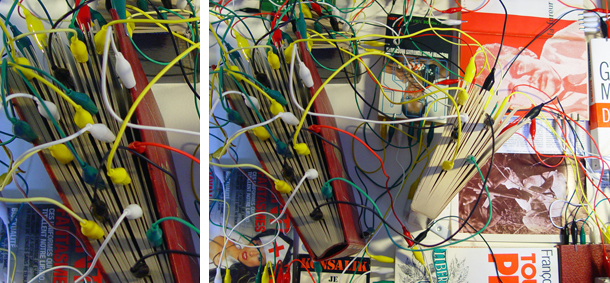
Serie started in 2006, inkjet prints, 105 x 160 cm.
Ed. of 5 + 2 A.P.
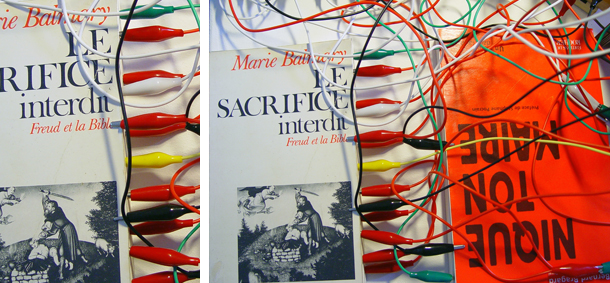
Serie started in 2006, inkjet prints, 105 x 160 cm.
Ed. of 5 + 2 A.P.
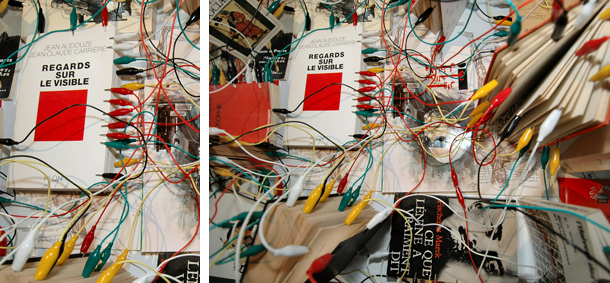
Serie started in 2006, inkjet prints, 105 x 160 cm.
Exhibition view from Comprendra bien qui comprendra le dernier, Le Parvis, 2004, Ibos.
Courtesy of the artist and Shoshana Wayne Gallery, Santa Monica.
Ed. of 5 + 2 A.P.
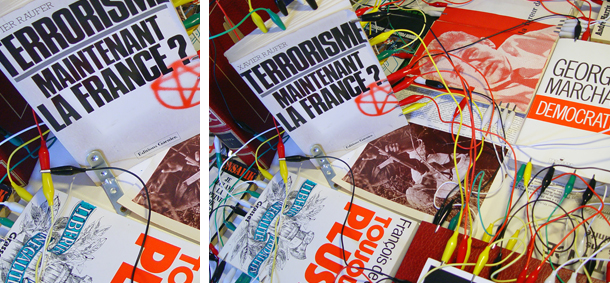
Serie started in 2006, inkjet prints, 105 x 160 cm.
Ed. of 5 + 2 A.P.

Serie started in 2006, inkjet prints, 160 x 105 cm.
Ed. of 5 + 2 A.P.
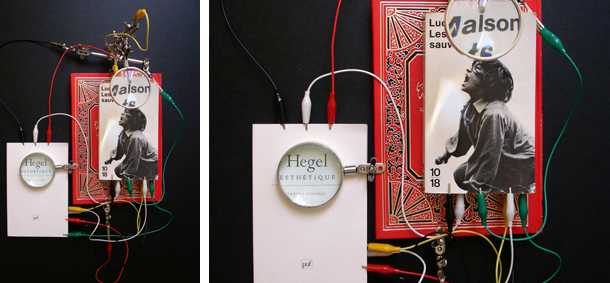
Serie started in 2006, inkjet prints, 160 x 105 cm.
Ed. of 5 + 2 A.P.
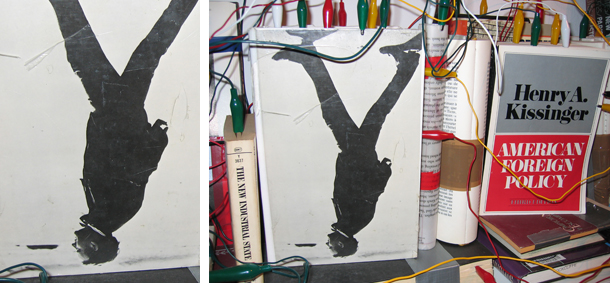
Serie started in 2006, inkjet prints, 105 x 160 cm.
Ed. of 5 + 2 A.P.
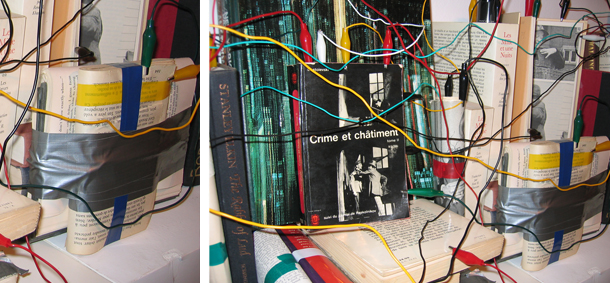
Serie started in 2006, inkjet prints, 105 x 160 cm.
Ed. of 5 + 2 A.P.
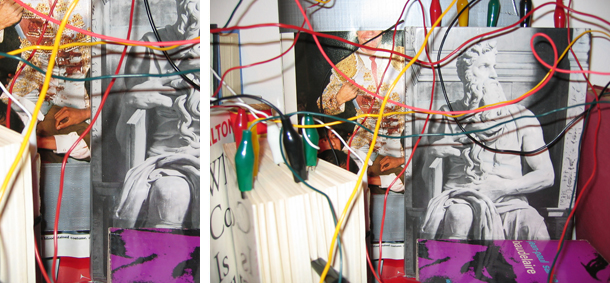
Serie started in 2006, inkjet prints, 105 x 160 cm.
Ed. of 5 + 2 A.P.
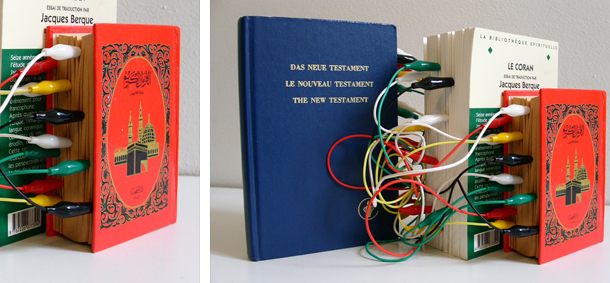
Serie started in 2006, inkjet prints, 105 x 160 cm.
Ed. of 5 + 2 A.P.
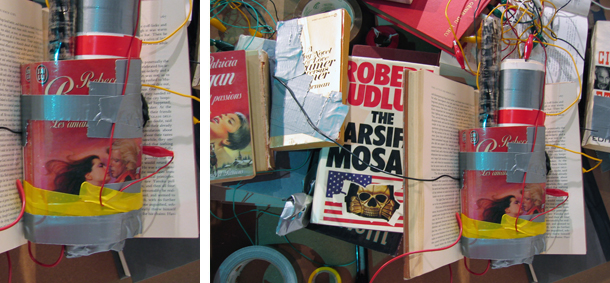
Serie started in 2006, inkjet prints, 105 x 160 cm.
Ed. of 5 + 2 A.P.
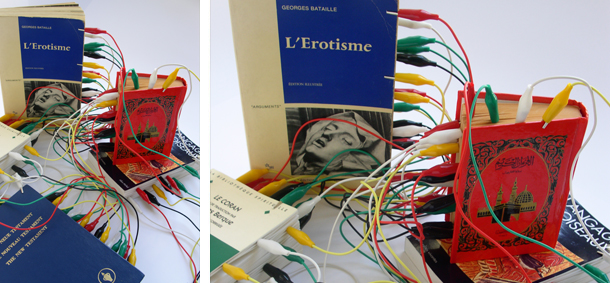
Series started in 2006, inkjet prints, 160 x 105 cm.
Courtesy of the artist and Shoshana Wayne Gallery, Santa Monica.
Ed. of 5 + 2 A.P.
'' How we read, scripture has the potential to ignite violence.
And yet, there’s also “an idea of transmission between these books…the work generates energy”. ''
Aaron Rosen, The Guardian, 2015

Connections
Exhibition View from Res publica, Moscow Museum of Modern Art, 2010, Moscow.
Courtesy of the artist.

Connections
Courtesy of the artist.
|
|
|
|
|
| Collection of Centre National des Arts Plastiques, Paris
Collection of De Nederlandsche Bank N.V., Amsterdam
Collection of Articulate Contemporary Art Fund, London
|
"Connexions" est une série de photographies en couleurs d'une partie d'une sculpture éponyme réalisée par Mounir Fatmi entre 2003 et 2009. L’œuvre est composée à l’aide de livres aux titres et aux couvertures variés, rédigés en arabe ou en français, disposés couchés ou debout sur leur tranche, et reliés entre eux par une multitude de câbles électriques de différentes couleurs. le format des photographies opère un agrandissement, un effet zoom sur l'installation et permet d'identifier la nature de certains des ouvrages exposés : textes religieux, traités philosophiques, romans policiers, enquêtes journalistiques, ou encore écrits politiques et historiques.
La série "Connexions" s'intéresse au livre et à la lecture sous un angle particulier : celui des rapports textuels, autrement nommés "intertextualité". L'œuvre traite ainsi de la mise en relation des livres et des connaissances. Le livre est un matériau récurrent des œuvres de Mounir Fatmi, où ses pouvoirs de diffusion et de transmission des connaissances ou au contraire d'empêchement et de censure sont étudiés. L'œuvre joue sur la multiplication des éléments entrant dans sa composition et sur l'hétérogénéité des matériaux exposés. Elle tend à égarer le spectateur dans une variété de genres et de styles. Elle l'invite à se perdre en elle et à suivre les fils reliant les ouvrages, afin de découvrir lesquels sont reliés entre eux et la raison éventuelle du lien effectué. "Connexions" stimule la curiosité du spectateur autant qu'elle déstabilise ce dernier en l'empêchant d'identifier un centre à la composition, ou un ouvrage plus important qu’un autre et faisant d'avantage autorité dans cette mise en scène de la connaissance livresque.
L'œuvre affirme finalement sa conception de la lecture et de l'activité intellectuelle en général. Toute lecture et toute réflexion, sont toujours mises en rapport : un texte ou une idée n'existent jamais seuls et renvoient à d’autres éléments de connaissances, en les confirmant ou au contraire en s'y opposant. L'intertextualité - et toute forme de mise en relation par extension - est cette capacité à découvrir ou à créer des liens entre les éléments les plus divers en apparence. La lecture s'apparente à une enquête journalistique ou policière (certains des livres exposés appartiennent d'ailleurs à ces genres) et exige un effort pour relier entre eux les indices. Par analogie avec un réseau électrique, elle est une activité intense, énergique… et non dénuée de risques. Elle est enfin un exercice éminemment critique et libre dans la mesure où elle réalise les connexions qu'elle désire.
Studio Fatmi, avril 2017.
|
|
Created between 2003 and 2009, “Connections” is a series of color photographs of an eponymous sculpture by Mounir Fatmi. The sculpture is composed of a multitude of books, in Arabic and French, covering a wide variety of subjects. Some books are displayed lying down, some are upright, all are connected by a mass of multi-colored electrical cables. The photographs act like a magnifying glass – zooming in on the installation and allowing us to identify the precise nature of the works that have been chosen by the artist: religious texts, philosophical treaties, murder mysteries, works of investigative journalism, political and historical non-fiction.
The “Connections” series examines the book and the act of reading from a particular angle: that of the connection between the works, often referred to as “intertextuality.” Thus, the photographs (and the sculpture) focus our attention on the relationship between the various books, and the knowledge contained within them. Books appear frequently in Mounir Fatmi’s work. They symbolize both the propagation and transmission of knowledge, and the eventual censorship that can ensue. “Connections” plays with heterogeneity: both in the choice of materials used in the sculpture’s composition, and in the choice of the books themselves. The viewers are invited to lose themselves in the wide variety of genres and styles on view, as well as in the intricate puzzle of the books’ connectedness. We attempt to follow the cables to determine which book is connected to which, and why. “Connections” stimulates the spectator’s curiosity while simultaneously destabilizing us, preventing us from identifying a center to the composition – no work is more important than another, no one work holds more authority than another in this assemblage of literary knowledge.
The piece asserts a certain vision of reading and of intellectual activity in general. To the artist, reading and reflection are fundamentally about drawing connections: a book does not exist in a vacuum, but in relationship to other texts – adding to them, modifying them, contradicting them. Indeed, at the core of the idea of intertextuality, and indeed at the core of all forms of relationship building, is the desire to discover or create links between elements that, on the surface, seem to have nothing in common. In this way, the act of reading becomes like a journalistic or criminal investigation (as certain books on view attest), requiring the reader to connect the necessary clues. To use the analogy of an electrical network, reading is an activity that is intense, energetic… and not without risk. Reading confers great liberty upon the reader, it is therefore of great threat to dogmatic ideologies everywhere. We are never so free as when we read to make the connections that we desire.
Studio Fatmi, April 2017.
|
|
|
|